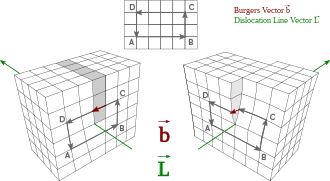
Back انحراف (هندسة مواد) Arabic Dislokasiya Azerbaijani Дислокация (материалознание) Bulgarian Versetzung (Materialwissenschaft) German Dislocación (defecto cristalino) Spanish Dislokatsioon Estonian نابجایی Persian Dislokaatio Finnish Dislocation (matériaux) French נקע (הנדסה) HE

In materials science, a dislocation or Taylor's dislocation is a linear crystallographic defect or irregularity within a crystal structure that contains an abrupt change in the arrangement of atoms. The movement of dislocations allow atoms to slide over each other at low stress levels and is known as glide or slip. The crystalline order is restored on either side of a glide dislocation but the atoms on one side have moved by one position. The crystalline order is not fully restored with a partial dislocation. A dislocation defines the boundary between slipped and unslipped regions of material and as a result, must either form a complete loop, intersect other dislocations or defects, or extend to the edges of the crystal.[1][2] A dislocation can be characterised by the distance and direction of movement it causes to atoms which is defined by the Burgers vector. Plastic deformation of a material occurs by the creation and movement of many dislocations. The number and arrangement of dislocations influences many of the properties of materials.
The two primary types of dislocations are sessile dislocations which are immobile and glissile dislocations which are mobile.[3] Examples of sessile dislocations are the stair-rod dislocation and the Lomer–Cottrell junction. The two main types of mobile dislocations are edge and screw dislocations.
Edge dislocations can be visualized as being caused by the termination of a plane of atoms in the middle of a crystal. In such a case, the surrounding planes are not straight, but instead bend around the edge of the terminating plane so that the crystal structure is perfectly ordered on either side. This phenomenon is analogous to half of a piece of paper inserted into a stack of paper, where the defect in the stack is noticeable only at the edge of the half sheet.
The theory describing the elastic fields of the defects was originally developed by Vito Volterra in 1907. In 1934, Egon Orowan, Michael Polanyi and G. I. Taylor, proposed that the low stresses observed to produce plastic deformation compared to theoretical predictions at the time could be explained in terms of the theory of dislocations.
- ^ Hull, D.; Bacon, D. J. (2001). Introduction to dislocations (4th ed.). Butterworth-Heinemann. doi:10.1016/B978-0-7506-4681-9.X5000-7. ISBN 978-0-7506-4681-9.
- ^ Anderson, Peter M.; Hirth, John Price; Lothe, Jens (2017). Theory of Dislocations (Third ed.). New York, NY: Cambridge University Press. ISBN 978-0-521-86436-7. OCLC 950750996.
- ^ "Dislocations in FCC materials". 2014-05-24. Retrieved 2019-11-08.